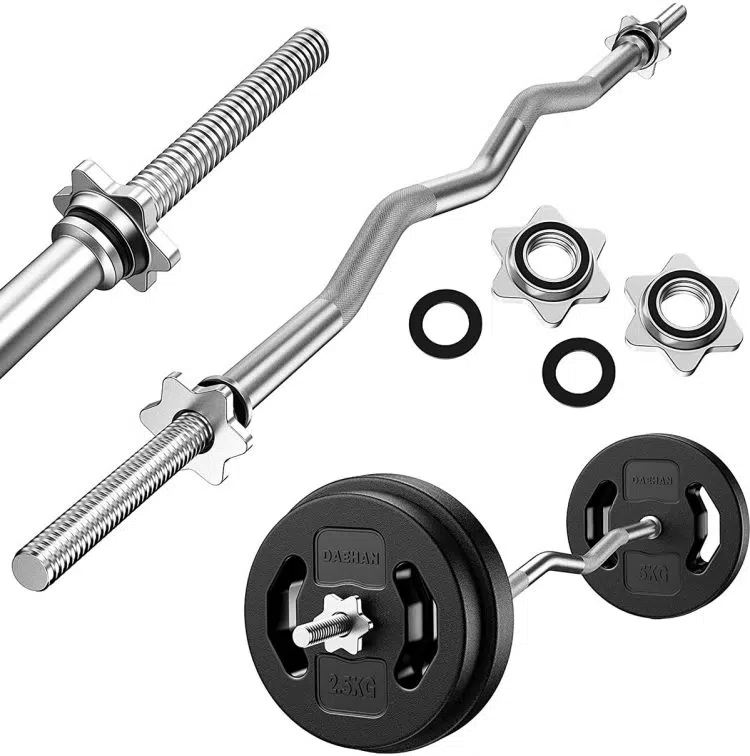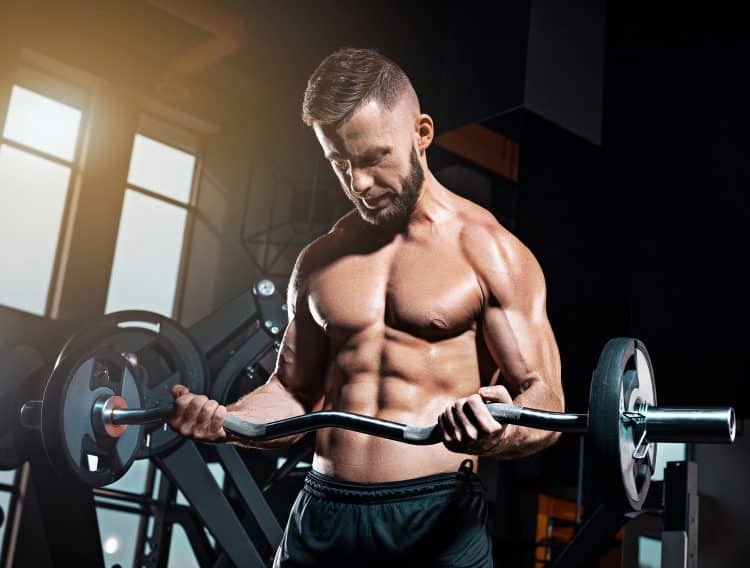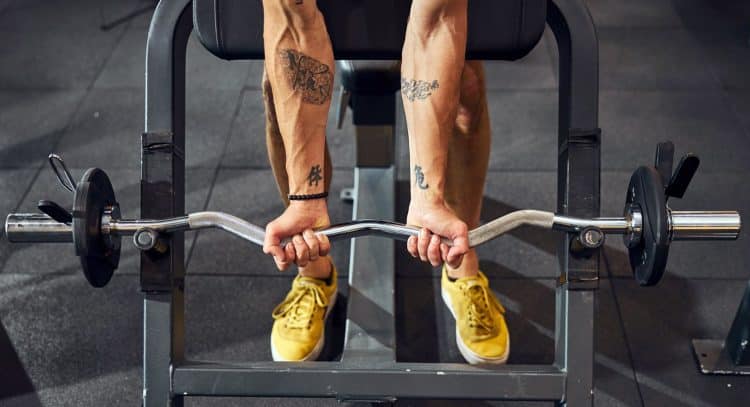If you hit the gym regularly, you’ve probably used a curl bar at some point. However, did you know the EZ bar comes in different shapes and sizes, and the bar you’ve been using for all your training life might not be the most optimal? Before you start despising your gym owner, let us clear the air.
What is a Curl Bar?
Although almost all bars can be used for curling, we’re addressing cambered bars in this article. Cambered bars, also known as curl or EZ bars, are training equipment used to lift weight plates. You could also find fixed (pre-loaded) curl barbells at high-end gyms.
The curl bar is most often used for the biceps curl, hence its name.
The Curl Bar Genesis
Lewis G. Dymeck, an Arizona native, invented the curl bar to help him lift while maintaining the correct form. It was originally known as the Dymeck curling bar. Interestingly, Dymeck was an FBI consultant and worked on the Atomic Energy Commission. Dymeck’s invention was 48 inches long with a 1 1/16-inch diameter. Dymeck filed for a patent in 1948 and was granted it in 1950. The patent states:
“As therefore proposed, the straight barbell device is one that is used for the standard exercises to affect the development of the arms and biceps. In these exercises, the instructions are always the same and recite that the exercise must be done with the strength of arms alone while keeping the elbows close to the user’s sides without swinging the body. However, very few persons can do such exercises correctly, since it is not natural or comfortable to do such exercise with a straight barbell.”
Get Fitter, FasterLevel Up Your Fitness: Join our 💪 strong community in Fitness Volt Newsletter. Get daily inspiration, expert-backed workouts, nutrition tips, the latest in strength sports, and the support you need to reach your goals. Subscribe for free!
As mentioned by the creator of the equipment, the curl bar is supposed to help you perform arm exercises with perfect form while keeping the elbows close to your sides without swinging your body.
In 1964, Bob Hoffman, founder of Muscular Development, bought the rights from Dymeck and started producing and selling the bar under the name EZ curl bar.
It’d be safe to say that the curved bar got its name because it was easy on the user’s joints and tendons than the conventional straight bar.
Differences Between a Standard Barbell and a Curl Bar
The standard barbells have a straight iron rod and a weight sleeve on each end. On the other hand, a curl bar has a “W” shaped iron rod in the center.
Unlike the standard straight bars, the curl bars come in different shapes and sizes. Most lifters prefer to perform biceps and triceps isolation exercises with these cambered bars. You’ll hardly ever see anyone use them for compound lifts like the shoulder press, bent-over barbell row, and deadlift. Not that it cannot be used; it’s just that most lifters prefer a straight bar for these exercises.
Curl Bar Benefits
The curl bar is the weapon of choice for many people, especially on their arms training day. Here are the advantages of adding the cambered barbell to your training regimen:
1. Kind on Your Wrists
It is no secret that the straight bar is the most popular type of barbell in strength sports. However, the straight bar can be taxing on your joints and tendons.
Because of the curl bar’s ergonomic design, your hands are at an angle while holding it, making the movement easier on your wrists and biceps tendons.
2. Better Grip
You are as strong as your weakest link in the weight room. And as it turns out, many people leave gains on the table because of their weak grip.
The EZ bar’s joint-friendly design helps you get a better grip on the bar. It is even more noticeable on exercises like the EZ bar skull crusher and overhead triceps extension.
3. Enhances Isolation
Since the curl bar comes in different sizes, it can help better isolate your target muscles. Experts believe a barbell’s length can impact muscle isolation while performing an exercise. A shorter bar can help better isolate the target muscles.
Why is that, you ask?
If you use a full-sized Olympic barbell for the biceps curl, your core and stabilizers kick into action to help you balance the long bar, taking tension off the target muscles. However, since smaller barbells are easier to balance, you can focus better on the primary muscles.
Furthermore, a 2018 study found better biceps activation while performing EZ bar curls than conventional barbell curls due to the more natural wrist position. [1]
4. Great for High Volume Workouts
Using a straight bar in high-volume and high-intensity workouts can lead to nagging wrist, biceps tendon, elbow, or shoulder pains. Plus, high-volume training sessions can fatigue you in the first half of your workouts, hampering your form.
Ergonomic training equipment like the curl bar can improve your range of motion, resulting in a better mind-muscle connection and muscle pumps.
5. Better Brachialis and Brachioradialis Stimulation
Your biceps consists of three muscles — the brachii, brachialis, and brachioradialis. The brachii, often referred to as the biceps, consists of two heads — short and long. The brachialis lies underneath the brachii and gives your biceps thickness. However, brachioradialis is the muscle you want to target if you want to build bigger forearms.
While using the curl bar, your hand position results in better recruitment of the brachialis and brachioradialis than the standard bar. Besides helping build bigger and stronger biceps and forearms, the curl bar improves your overall functioning.
Check Out: Average Biceps Size: How Do You Measure Up?
Why Should You Know Your Curl Bar Weight?
Following a balanced training program is the most effective and efficient way of building muscle mass and strength. Besides including a well-laid-out exercise routine, a balanced training program should structure your rest time between sets and sessions, rep tempo, and incorporate advanced training principles. It doesn’t end here. You should also know the weights you should use for your workouts.
Contrary to what most people think, you do not have to pile on every weight plate you can find onto a curl bar to build bigger muscles. A weight that will help you achieve failure in the 8-12 rep range is the most optimal for hypertrophy. [2]
Knowing the weight of the curl bar can help you use the right amount of weight for your sets. Many people put too much weight on the bar and risk getting injured. On the other hand, many lifters leave gains on the table by going too light for their experience level.
Knowing the ballpark weight figure of all curl bars will ensure you get the best bang for your buck.
Also, if you’re a strict curl competitor, it is imperative that you know the exact weight of your curl bar.
Trivia: Leroy Walker holds the world record for the heaviest strict curl — 114 kilograms (250 pounds) — using the super curl bar.
How Much Does a Curl Bar Weigh? 6 Different EZ Bars Compared
Knowing the difference between curl bars, their properties, and their weights will help you choose the right bar for your workouts. On the other hand, this guide will help you make an informed decision if you’re in the market for a curl bar for your home gym. So, without any further ado, here are the six EZ bars you should know about:
Level Up Your Fitness: Join our 💪 strong community in Fitness Volt Newsletter. Get daily inspiration, expert-backed workouts, nutrition tips, the latest in strength sports, and the support you need to reach your goals. Subscribe for free!
1. Standard Curl Bar
The standard curl bar is the entry-level EZ barbell. It has threaded sleeves to attach collars and keep them in place after the weights are loaded.
The standard curl bar has 1-inch diameter sleeves, meaning you can’t use Olympic plates on these bars — unless you like wobbling bars. A standard EZ bar can handle up to 200 pounds, is 47 inches long, has 6.5-inch sleeves, and weighs 8-12 pounds.
| Bar Weight | Size | Diameter | Sleeve Length | Weight Capacity |
| 8-12 pounds | 47 inches | 1-inch | 6.5 inches | 200 pounds |
2. EZ Curl Bar
The first two curl bars on this list are suitable for your home gym. The EZ curl bar has less pronounced curves in the middle than standard curl bars. This type of bar is generally used for the preacher curl. The EZ curl bar has threaded 1-inch diameter sleeves like the standard curl bar.
It can be incredibly difficult for the untrained eye to differentiate between EZ and standard curl bars. EZ curl bars weigh between 11 and 13 pounds and are 47-50 inches long.
| Bar Weight | Size | Diameter | Sleeve Length | Weight Capacity |
| 11-13 pounds | 47 inches | 1-inch | 6.5 inches | 200 pounds |
3. Olympic Curl Bar
The Olympic curl bar is arguably the most popular type of EZ curl bar in gyms across the world. There are a few differences that set it apart from the EZ and standard curl bar.
To begin with, it has rotating sleeves, which allow the weights to move with your natural motion. It eliminates unnecessary wrist and biceps tendon stress and helps you focus on the target muscle.
Plus, Olympic curl bars weigh between 18 and 25 pounds, are 47-52 inches long, and have 6.5-inch on either end. These bars have a 2-inch sleeve diameter, making them suitable for the standard Olympic barbell.
| Bar Weight | Size | Diameter | Sleeve Length | Weight Capacity |
| 18-25 pounds | 47-52 inches | 2-inch | 6.5 inches | 200-250 pounds |
4. Fixed-Weight Curl Bar
You’re more likely to find fixed-weight curl bars in high-end gyms. As the name suggests, these curl barbells come with weights pre-loaded, and you cannot adjust the weight on the bar.
The fixed-weight curl bars are usually the shortest as they do not require weight sleeves. They also have moderate curves like the EZ bar curl. These curl bars can be between 38 and 48 inches in length.
| Bar Weight | Size | Diameter | Sleeve Length | Weight Capacity |
| 20-100 pounds | 38-45 inches | NA | NA | NA |
5. Rackable Curl Bar
The rackable curl bar is a great curl bar variation for exercises like bench presses and triceps skull crushers. You should prefer this bar if you train alone at the gym or want an EZ bar for your home gym.
The length of the rackable curl bar makes it great to be used inside a power rack, making it easier to load and unload the weights.
The rackable curl bar is the longest curl bar and can measure between 74 and 75 inches. This EZ bar variation can also be the heaviest non-pre-loaded curl bar because of the extra length. The rackable EZ bar has 2-inch diameter sleeves that can take Olympic weight plates.
| Bar Weight | Size | Diameter | Sleeve Length | Weight Capacity |
| 35 pounds | 74-75 inches | 2-inch | 6.5 inches | 250-300 pounds |
6. Super Curl Bar
If this article were a curl bar fashion show, the super curl bar would be the show stopper.
The super curl bar has the deepest curves of the bunch. The design of this bar alleviates excess stress from your wrists and elbows while performing heavy arm exercises.
Strict curl competitors generally use the super curl bar as it allows them to generate the most power while reducing the chances of wrist, forearm, and elbow injury.
The super curl bar uses 2-inch diameter sleeves that can take Olympic weight plates. They weigh between 18 and 24 pounds and are 38-45 inches long.
| Bar Weight | Size | Diameter | Sleeve Length | Weight Capacity |
| 18-24 pounds | 38-45 inches | 2-inch | 6.5 inches | 250-300 pounds |
Here is a chart for a quick comparison of the six curl bars and their features:
| Name | Bar Weight | Size | Diameter | Sleeve Length | Weight Capacity |
| Standard Curl Bar | 8-12 pounds | 47 inches | 1-inch | 6.5 inches | 200 pounds |
| EZ Curl Bar | 11-13 pounds | 47 inches | 1-inch | 6.5 inches | 200 pounds |
| Olympic Curl Bar | 18-25 pounds | 47-52 inches | 2-inch | 6.5 inches | 200-250 pounds |
| Fixed-Weight Curl Bar | 20-100 pounds | 38-45 inches | NA | NA | NA |
| Rackable Curl Bar | 35 pounds | 74-75 inches | 2-inch | 6.5 inches | 250-300 pounds |
| Super Curl Bar | 18-24 pounds | 38-45 inches | 2-inch | 6.5 inches | 250-300 pounds |
Things To Consider While Choosing a Curl Bar
You should look at the following factors before choosing an EZ bar:
1. Grip
The curl bar you choose should depend on your mobility and if you’re dealing with any injuries. If you’re dealing with muscle or joint pains, you should select a bar with deeper curves that put your wrists in an almost neutral position.
Make sure you try out both gripping positions of the curl bar since you’ll be using both the wide-grip and close-grip positions. Many brands have a perfect wide-grip position, but the close-grip puts your forearms and elbows in an awkward position.
On the other hand, if you want to set a new biceps curl or triceps extension PR, the super curl bar should be the preferred EZ bar.
2. Length
Longer bars require greater core and stabilizer recruitment. If you want to isolate your target muscle groups, you should opt for smaller curl bars, like the fixed-weight barbells. However, the rackable curl bar should be the way to go if you want to go heavy.
3. Build
Different brands follow different manufacturing practices, material, and standards, which determines the quality of an EZ bar. Most brands also use different knurling patterns and sizes that can impact your buying decision.
4. Sleeves
Depending on your use case, you might want a curl bar with a 1-inch or 2-inch diameter sleeve. If you have weight plates with 1-inch diameter holes, you’ll want the standard or EZ curl bar. However, the Olympic, rackable, or super curl bars are the right curl bars for you if you have Olympic weight plates.
5. Weight
The curl bar weight is also a major factor in determining which barbell you should choose. If you’re a newbie, you’d be better off with lighter 8-13-pound curved bars like the standard or EZ curl bar with in-built threaded sleeves to attach collars. On the other hand, more experienced lifters can use pre-loaded, Olympic, rackable, or super curl bars.
Most Popular Exercises — Curl Bar
Given below are the most popular curl bar exercises that should be a part of your training regimen:
- EZ Bar Biceps Curl
- EZ Bar Reverse Grip Curl
- Cambered Bar Skull Crusher
- Curl Bar Close-Grip Bench Press
- EZ Bar Overhead Triceps Extension
- Curl Bar Upright Row
- EZ Bar 21s
- EZ Bar Front Raise
FAQs
What is the ideal length and weight of a curl bar to best isolate your muscles?
The jury is still out on this one. You should select the bar length that best suits your body type. For example, endomorphs could be the most comfortable with the super curl bar, while endomorphs might prefer curl bars in the 47-52 inches range.
How to weigh a curl bar?
If you’re not sure about the weight of your curl bar, you could place it on a weighing scale. Make sure you balance it in the center where the ends aren’t touching the ground. Alternatively, you could first weigh yourself and then weigh yourself again while holding onto the curl bar. You then subtract your body weight from the second reading.
Do all curl bars weigh the same?
No, all curl bars do not weigh the same. Even bars from the same category might weigh differently because of a brand’s manufacturing practices, quality, and size.
How much weight should you use on a curl bar?
Irrespective of the training equipment or exercise, you should lift based on your experience level. If you cannot perform an exercise with the correct form, you should drop the weight immediately to reduce your chances of injury.
Wrapping Up
The curl bar allows better arm isolation due to its close-to-neutral gripping position. It can help take your gains to the next level and break through plateaus.
Knowing the curl bar weight will ensure you’re not using a resistance that will jeopardize your gains. Learning about the EZ bar weight can help ignite new growth and limit your chances of injury.
References
- Marcolin G, Panizzolo FA, Petrone N, Moro T, Grigoletto D, Piccolo D, Paoli A. Differences in electromyographic activity of biceps brachii and brachioradialis while performing three variants of curl. PeerJ. 2018 Jul 13;6:e5165. doi: 10.7717/peerj.5165. PMID: 30013836; PMCID: PMC6047503.
- Schoenfeld BJ, Grgic J, Van Every DW, Plotkin DL. Loading Recommendations for Muscle Strength, Hypertrophy, and Local Endurance: A Re-Examination of the Repetition Continuum. Sports (Basel). 2021 Feb 22;9(2):32. doi: 10.3390/sports9020032. PMID: 33671664; PMCID: PMC7927075.











